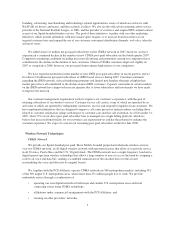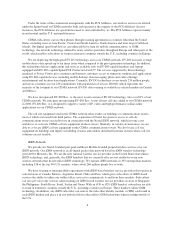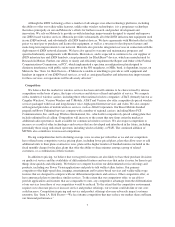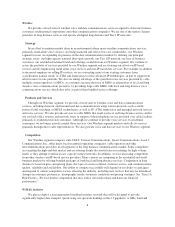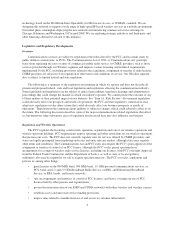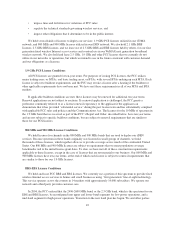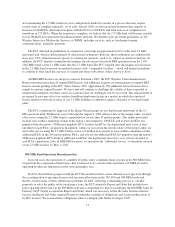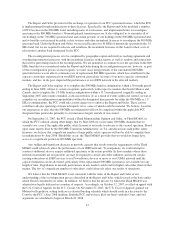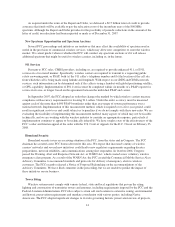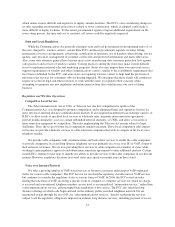Sprint - Nextel 2007 Annual Report Download - page 16
Download and view the complete annual report
Please find page 16 of the 2007 Sprint - Nextel annual report below. You can navigate through the pages in the report by either clicking on the pages listed below, or by using the keyword search tool below to find specific information within the annual report.As required under the terms of the Report and Order, we delivered a $2.5 billion letter of credit to provide
assurance that funds will be available to pay the relocation costs of the incumbent users of the 800 MHz
spectrum. Although the Report and Order provides for the possibility of periodic reductions in the amount of the
letter of credit, no reductions had been requested or made as of December 31, 2007.
New Spectrum Opportunities and Spectrum Auctions
Several FCC proceedings and initiatives are underway that may affect the availability of spectrum used or
useful in the provision of commercial wireless services, which may allow new competitors to enter the wireless
market. We cannot predict when or whether the FCC will conduct any spectrum auctions or if it will release
additional spectrum that might be useful to wireless carriers, including us, in the future.
911 Services
Pursuant to FCC rules, CMRS providers, including us, are required to provide enhanced 911, or E911,
services in a two-tiered manner. Specifically, wireless carriers are required to transmit to a requesting public
safety answering point, or PSAP, both (a) the 911 caller’s telephone number and (b) the location of the cell site
from which the call is being made using latitude and longitude. With respect to our iDEN and CDMA network
services, such information can be determined only if the caller is using a handset with global positioning satellite,
or GPS, capability. Implementation of E911 service must be completed within six months of a PSAP request for
service in its area, or longer, based on the agreement between the individual PSAP and carrier.
In September 2007, the FCC adopted an order that changes the method by which wireless carriers measure
compliance with accuracy requirements for locating 911 callers. Under the order, accuracy must be measured
against each of the more than 6,000 PSAP boundaries rather than an average of system performance over a
national network. Implementation of this measurement method, which is required over a five-year period, could
result in significant costs to us and could subject us to penalties if we do not comply with these new rules. We are
evaluating the feasibility of implementing this measurement method, many aspects of which may not be feasible
technically, and we are working with the wireless industry to consider an appropriate response, particularly if
implementation continues to appear to be technically infeasible. We have sought a stay of the effectiveness of the
FCC’s order and filed an appeal of the order with the U.S. Court of Appeals for the D.C. Circuit on February 25,
2008.
Homeland Security
Homeland security issues are receiving attention at the FCC, from the states and in Congress. The FCC
chairman has created a new FCC bureau devoted to this area. We expect that increased scrutiny of wireless
carriers’ networks and several new initiatives could lead to new regulatory requirements regarding disaster
preparedness, network reliability, and communications among first responders. In October 2006, Congress
passed the Warning, Alert and Response Network Act, or WARN Act, which created a new voluntary wireless
emergency alert program. As a result of the WARN Act, the FCC created the Commercial Mobile Service Alert
Advisory Committee to recommend standards and protocols for delivery of emergency alerts to wireless
customers. The FCC recently released a Notice of Proposed Rulemaking on the recommendations of the
Advisory Committee. We have filed comments in the proceeding, but we are unable to predict the impact of
these initiatives on our business.
Tower Siting
Wireless systems must comply with various federal, state and local regulations that govern the siting,
lighting and construction of transmitter towers and antennas, including requirements imposed by the FCC and the
Federal Aviation Administration. FCC rules subject certain cell site locations to extensive zoning, environmental
and historic preservation requirements and mandate consultation with various parties, including Native
Americans. The FCC adopted significant changes to its rules governing historic preservation review of projects,
14



